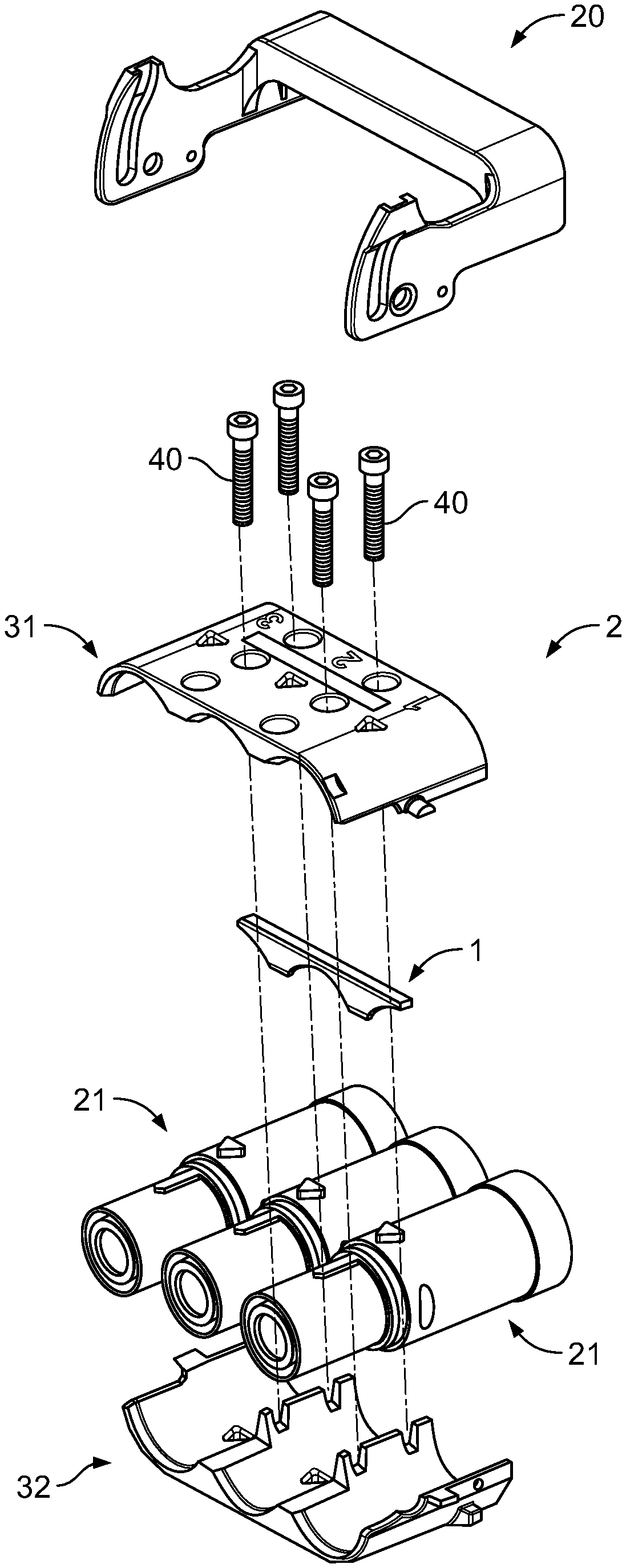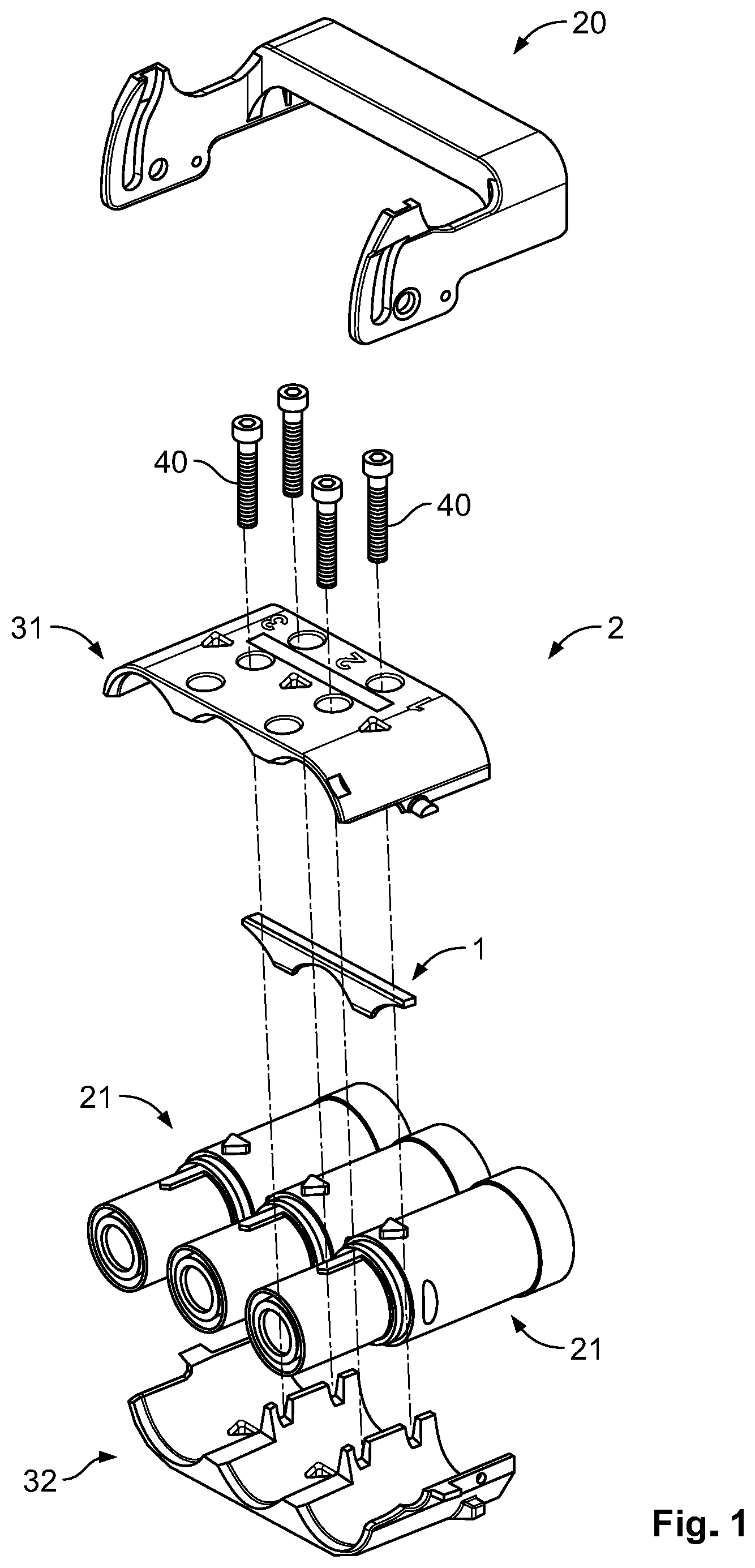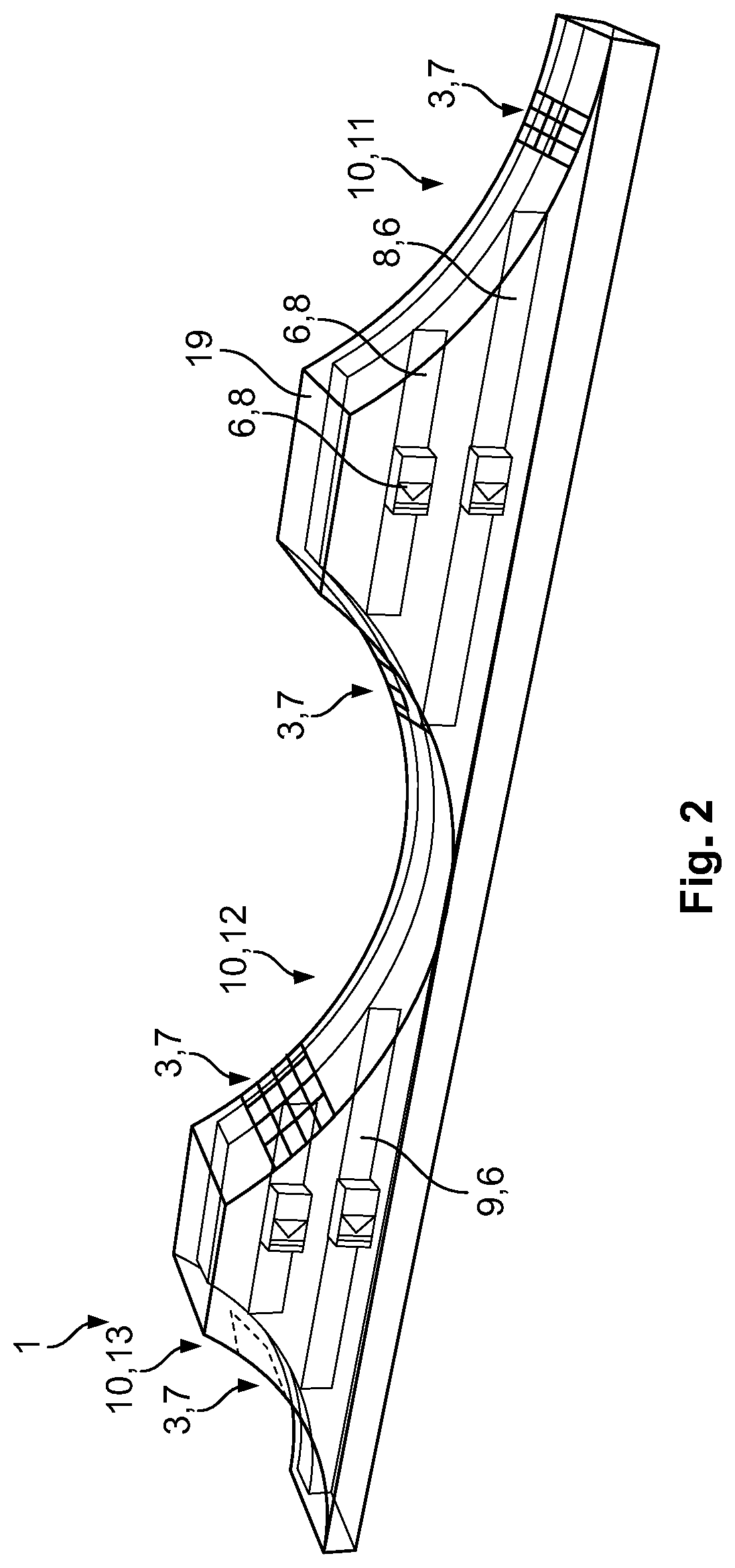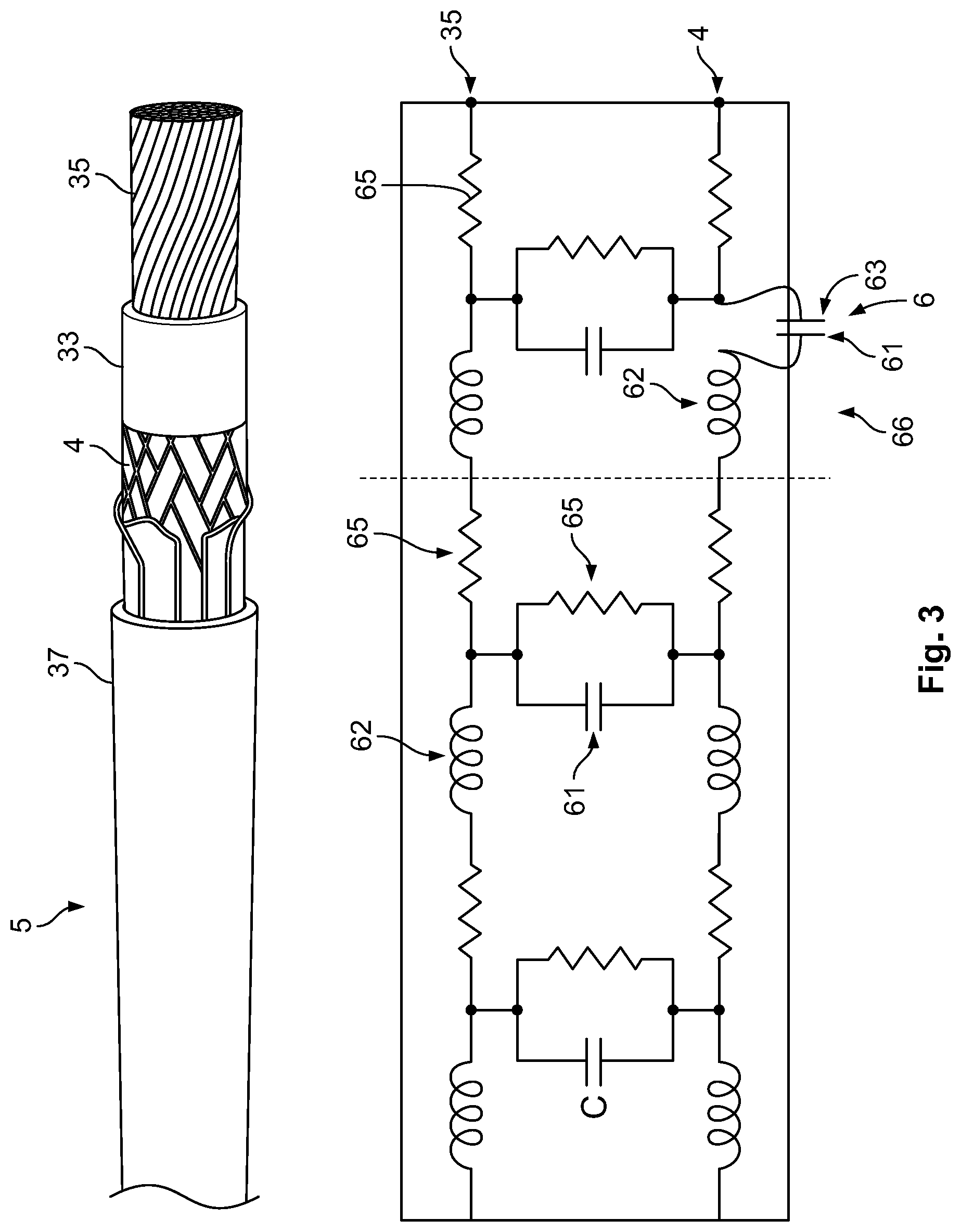Module For A High-Current Plug And/Or A High-Current Cable, High-Current Plug, And Method Of Influencing The EMC Behaviour
Bischoff; Daniel ; et al.
U.S. patent application number 16/794890 was filed with the patent office on 2020-06-11 for module for a high-current plug and/or a high-current cable, high-current plug, and method of influencing the emc behaviour. This patent application is currently assigned to TE Connectivity Germany GmbH. The applicant listed for this patent is TE Connectivity Germany GmbH. Invention is credited to Daniel Bischoff, Jens Koester, Mohammad Nikfal.
| Application Number | 20200185864 16/794890 |
| Document ID | / |
| Family ID | 64051557 |
| Filed Date | 2020-06-11 |




| United States Patent Application | 20200185864 |
| Kind Code | A1 |
| Bischoff; Daniel ; et al. | June 11, 2020 |
Module For A High-Current Plug And/Or A High-Current Cable, High-Current Plug, And Method Of Influencing The EMC Behaviour
Abstract
A module for a high-current plug and/or a high-current cable includes a coupling face coupling to a shield and an influencing device influencing an electromagnetic property of the shield.
| Inventors: | Bischoff; Daniel; (Buettelborn, DE) ; Koester; Jens; (Rossdorf, DE) ; Nikfal; Mohammad; (Darmstadt, DE) | ||||||||||
| Applicant: |
|
||||||||||
|---|---|---|---|---|---|---|---|---|---|---|---|
| Assignee: | TE Connectivity Germany
GmbH Bensheim DE |
||||||||||
| Family ID: | 64051557 | ||||||||||
| Appl. No.: | 16/794890 | ||||||||||
| Filed: | February 19, 2020 |
Related U.S. Patent Documents
| Application Number | Filing Date | Patent Number | ||
|---|---|---|---|---|
| PCT/EP2018/079472 | Oct 26, 2018 | |||
| 16794890 | ||||
| Current U.S. Class: | 1/1 |
| Current CPC Class: | H01R 13/6592 20130101; H01R 13/6464 20130101; H01R 2105/00 20130101 |
| International Class: | H01R 13/6592 20060101 H01R013/6592; H01R 13/6464 20060101 H01R013/6464 |
Foreign Application Data
| Date | Code | Application Number |
|---|---|---|
| Nov 2, 2017 | DE | 102017219493.6 |
Claims
1. A module for a high-current plug and/or a high-current cable, comprising: a coupling face coupling to a shield; and an influencing device influencing an electromagnetic property of the shield.
2. The module of claim 1, further comprising a contact face electrically contacting the shield.
3. The module of claim 2, wherein the coupling face is the contact face.
4. The module of claim 1, wherein the influencing device is a resistor, an inductor, and/or a capacitor.
5. The module of claim 1, wherein the influencing device is a metal plate.
6. The module of claim 1, wherein the influencing device influences a radiation property of the shield.
7. The module of claim 1, wherein at least a part of the influencing device is exchangeable.
8. The module of claim 1, wherein the influencing device is tunable.
9. The module of claim 2, further comprising a curve contacting the shield.
10. The module of claim 9, wherein the coupling face or the contact face are arranged in the curve.
11. The module of claim 1, further comprising a first curve and a second curve, the influencing device is arranged between the first curve and the second curve.
12. The module of claim 1, further comprising a first curve and a second curve, the influencing device extends from the first curve to the second curve.
13. The module of claim 1, further comprising an injection-molded element, the influencing device is embedded in the injection-molded element.
14. A high-current plug, comprising: a module including a coupling face coupling to a shield and an influencing device influencing an electromagnetic property of the shield.
15. A method for influencing an electromagnetic compatibility of a high-current cable, comprising: fitting a module influencing a shield current of a shield to the high-current cable.
Description
CROSS-REFERENCE TO RELATED APPLICATIONS
[0001] This application is a continuation of PCT International Application No. PCT/EP2018/079472, filed on Oct. 26, 2018, which claims priority under 35 U.S.C. .sctn. 119 to German Patent Application No. 102017219493.6, filed on Nov. 2, 2017.
FIELD OF THE INVENTION
[0002] The present invention relates to a module and, more particularly, to a module for a high-current plug.
BACKGROUND
[0003] In the case of high currents, especially when alternating currents or pulsed currents are involved, currents can occur even in a shield of shielded cables such as coaxial cables. These currents lead to an electromagnetic field outside the cable and thereby cause disturbances at other components.
[0004] A previous method for controlling frequency and power is the PWD-VFD (Pulse Width Modulation--Variable Frequency Drive). Here an alternating current is generated by switching a direct current successively in alternating directions. The switching produces significant quantities of common mode noise (CMN), which has to be taken up by the power and grounding systems and dissipated (>1 MHz). To prevent these stray currents from damaging or disrupting the system components, the grounding system must provide a path with low impedance for the currents of the CMN. At the same time, shield currents with low frequencies (<1 KHz) should be reduced in the shielded cables on account of the heat build-up in the plug.
SUMMARY
[0005] A module for a high-current plug and/or a high-current cable includes a coupling face coupling to a shield and an influencing device influencing an electromagnetic property of the shield.
BRIEF DESCRIPTION OF THE DRAWINGS
[0006] The invention will now be described by way of example with reference to the accompanying Figures, of which:
[0007] FIG. 1 is an exploded perspective view of a high-current plug according to an embodiment;
[0008] FIG. 2 is a perspective view of a module of the high-current plug; and
[0009] FIG. 3 is a perspective view of a high-current cable and a schematic electric circuit according to an embodiment.
DETAILED DESCRIPTION OF THE EMBODIMENT(S)
[0010] The present disclosure will be described hereinafter in further detail with reference to the following embodiments, taken in conjunction with the accompanying drawings. In the specification, the same or similar reference numerals indicate the same or similar parts. The description of the embodiments of the present disclosure hereinafter with reference to the accompanying drawings is intended to explain the general inventive concept of the present disclosure, and should not be constructed as a limitation to the present disclosure. The embodiments and configurations depicted here are each independent of one another and can be combined with one another in any way, according to necessity in a particular application.
[0011] A high-current plug 2 according to an embodiment is shown in FIG. 1. The high-current plug 2 has a plurality of sleeves 21, three in the shown embodiment, which are used for the different phases of a three-phase current. The sleeves 21 are arranged between an upper shell 31 and a lower shell 32 of the plug 2, which are attached to one another by a plurality of screws 40.
[0012] The high-current plug 2, as shown in FIG. 1, includes a lever 20. The high-current plug 2 can be pressed onto a mating plug with the lever 20.
[0013] The high current plug 2 includes a module 1, shown in FIGS. 1 and 2, arranged between the upper shell 31 and the sleeves 21. The module 1 is used to influence the electromagnetic properties of a shield 4 of a connected high-current cable 5, shown in FIG. 3, in a desired manner. By the use of the module 1, currents flowing in the shield 4 can be altered in such a way that, for example, an electromagnetic field generated by the current of the shield 4 is below permissible values and does not disturb any adjacent components or mechanisms. In an embodiment, the module 1 is a passive filter, which reduces a current in an undesirable frequency range.
[0014] In an embodiment, the high-current plug 2 has a receptacle for the module 1. The module 1 can be configured complementarily to the receptacle.
[0015] As shown in FIG. 2, the module 1 has a plurality of coupling faces 3, which are contact faces 7 at which electrical contact takes place. The module 1 has a plurality of influencing devices 6, which influence the electrical properties of a coupled shield 4 in a desired manner. The influencing devices 6 can be electrical structural components 8, such as, for instance, inductors 62, capacitors 63, resistors 65 or similar, as shown in FIG. 3.
[0016] In an embodiment, the influencing device 6 can be formed, for example, by a metal plate 9 and/or comprise such a metal plate 9 as shown in FIG. 2. The metal plate 9 can be configured in such a way that it produces a desired influencing of the shield current. The size and shape that such a metal plate 9 must have in order to achieve a desired influencing can be calculated by a simulation, for example.
[0017] In an embodiment, whether the influencing device 6 is an electrical structural component 8 or a metal plate 9 is selected according to an electromagnetic behavior to influence the shield 4; the influencing device 6 can be chosen based on application and optimized for the application.
[0018] If several elements are present in the influencing device 6, these can form an electric circuit 66 shown in FIG. 3. The influencing device 6 can be tunable, for example by tunable elements such as adjustable resistors 65, inductors 62 or capacitors 63 shown in FIG. 3. The influencing device 6 can thereby be used in various applications. Furthermore, various components can be exchangeable.
[0019] As shown in FIG. 2, the module 1 has a plurality of curves 10, which are adapted to the circular cross section of the high-current cable 5 and the sleeves 21. The coupling faces 3 lie respectively on the inside of the curves 10. In the embodiment shown, three curves 10 are present. A first curve 10, 11 and a third curve 10, 13 lie on the outside of module 1 and are roughly half as wide as a second curve 10, 12, which lies in a center between the first curve 10, 11 and the third curve 10, 13. Two influencing devices 6 present each extend from the first curve 10, 11 to the adjacent second curve 10, 12. They are each arranged between two curves 10. They can be configured, for example, in such a way that a single influencing device 6 can be used for two shields 4.
[0020] The module 1, as shown in FIG. 2, has an injection-molded element 19, in which the influencing devices 6 are embedded. The module 1 is thereby stable and the influencing device 6 is protected against water and dust.
[0021] The high-current cable 5 and an equivalent circuit diagram are shown in FIG. 3. The high-current cable 5 has an inner conductor 35, an inner insulation 33 arranged over the inner conductor 35, which is enclosed in turn by the shield 4 and an external insulation 37. The high-current cable 5 has capacitances 61, inductances 62 and resistances 65, which are depicted in the equivalent circuit diagram.
[0022] The coupling faces 3, or contact faces 7, are coupled to and electrically contact the shield 4, the curves 10 permit a simple connection between the contact face 7 and the shield 4. The contact faces 7 are positioned externally and on a side of the module 1 facing the shield 4. The module 1 is thereby fitted on the high-current plug 2 and/or the high-current cable 5. In an embodiment, the high-current plug 2 has a pressing mechanism pressing the module 1 onto the shield 4. In another embodiment, a contactless coupling can take place, for example inductively or capacitively.
[0023] Due to the coupling of the influencing device 6, which can add a further capacitance 61 in the form of a capacitor 63, the electromagnetic properties and electromagnetic compatibility (EMC) of the shield 4 and the high-current cable 5 can be influenced positively. The influencing device 6 can be configured to influence the radiation properties of the shield 4 in order to prevent a disruption of adjacent mechanisms. To facilitate adaptation to different high-current mechanisms, at least a part of the influencing device 6 can be exchangeable. For example, electrical components 8 such as resistors 65, coils, or capacitors 63 can be exchangeable. The shield 4 current and/or a radiation behavior of the high-current cable 5, such as a coaxial cable, and high-current plugs can then be improved and/or controlled.
[0024] In another embodiment, the module 1 can also be used outside of the high-current plug 2; the module 1 can be used on a cable harness.
* * * * *
D00000

D00001

D00002

D00003

XML
uspto.report is an independent third-party trademark research tool that is not affiliated, endorsed, or sponsored by the United States Patent and Trademark Office (USPTO) or any other governmental organization. The information provided by uspto.report is based on publicly available data at the time of writing and is intended for informational purposes only.
While we strive to provide accurate and up-to-date information, we do not guarantee the accuracy, completeness, reliability, or suitability of the information displayed on this site. The use of this site is at your own risk. Any reliance you place on such information is therefore strictly at your own risk.
All official trademark data, including owner information, should be verified by visiting the official USPTO website at www.uspto.gov. This site is not intended to replace professional legal advice and should not be used as a substitute for consulting with a legal professional who is knowledgeable about trademark law.